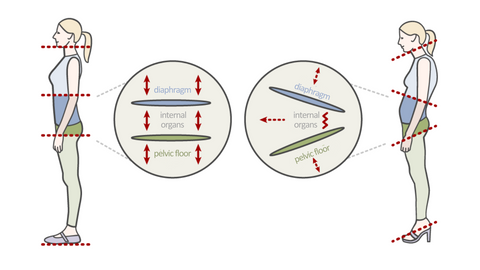We know why high-heels are making your back hurt (and we’ve got bad news)
If you feel like your high-heels are giving you back pain, we've got bad news for you:
They are.
Your favorite pumps are affecting your whole body. According to a new study, they’re overburdening your back muscles, weakening your abdominal muscles and increasing your risk of arthritis.Does this mean you have to give up high heels once and for all?
How can a few inches below the heel change your posture?
What shoes should you be wearing then?
Let's have a look!

Good news: You don't have to wear heels in public. You can wear stylish shoes that are also healthy.
How high-heels tilt our pelvis forward
Have you ever noticed that you stand and walk differently in high-heels? A study carried out by Palacký University in Olomouc confirms this: “Walking in shoes with heels increases muscle activity and changes the stereotype of walking. For this reason, it places much higher demands on controlling movement."
In simple terms: Everything in the human body is interconnected. When you tilt the foot forward with heels, you’re changing the muscle tension and the position of the body. This imbalance continues to spread:
- The knees lock backwards.
- The pelvis tilts forward.
- Tension of the pelvic floor changes.
We wrote about the pelvic floor in the article How can you strengthen the pelvic floor? 6 simple exercises. Did you know that proper tension in it is also important for pleasurable sexual experiences?

Heels change the inclination of the foot, thus affecting the whole body.
Wearing heels makes us stick out our bellies and tense up our backs
What happens when you tilt the pelvis forward? Your belly sticks out and your back arches.
The abdomen slackens and the flabby abdominal muscles cease to function. Normally, these muscles work together with the back muscles to stabilize the spine. But now, these back muscles are on their own and therefore have to work harder.
This is why the back muscles tense up and become overworked. Then pain sets in.
Heeled shoes are not the only cause of back pain. Muscle tension runs through the entire body and can lead to neck pain or headaches.
"Due to the forward tilt of the pelvis, the lumbar vertebrae are placed in an unnatural position. Slight arching or lordosis is ok, but heels cause increased flexion and overload the vertebrae."
Lukáš Klimpera, physiotherapist

Heels alter the tilt of the pelvis. The abdomen slackens, the back tenses up and the internal organs are subjected to unnatural pressure.
When stretching isn’t enough
You might be thinking, "Oh well, so my back is hurting. I'll just stretch, get a massage, and I'll be fine."
Unfortunately, that may not be enough. According to physiotherapist Lukáš Klimpera, long-term overloading of the back muscles and the vertebrae of the lumbar spine can lead to serious damage.
"Wearing heels regularly loosens the muscles of the abdominal wall. Therefore, the spine has to be stabilized by the back muscles, which aren’t able to carry heavier loads. This leads to strains and prolapses."
Lukáš Klimpera, physiotherapist

Physiotherapists recommend wearing shoes without heels and with a wide toe box.
Changes are already noticeable in young women, warns a doctor
An interesting study was recently conducted in collaboration between the Clinic of Rehabilitation Medicine of the General University Hospital in Prague, the 1st Faculty of Medicine of Charles University in Prague and Hacettepe University in Ankara. It examined women around 30 years of age who regularly wear high-heeled shoes.
In addition to back pain and foot deformities, the study showed that high-heels destroy knee cartilage. The changes were already evident in very young women, as ultrasounds revealed a higher risk of arthritis among them.
"We’ve shown that the prolonged wearing of high heels negatively affects the structure of the Achilles tendon and causes early arthritic changes in the knee cartilage. This is also true in young women."
Kamal Mezian, doctor at the Clinic of Rehabilitation Medicine at the VFN and 1st Faculty of Medicine, Charles University
Dr. Mezian discusses the study in an interview with DVTV. If you don't have any plans for the next fifteen minutes, we recommend you listen to the interview.

When wearing shoes with heels, you’re shifting your weight to the heel of your foot and overburdening it.
What other problems do high heels cause?
➡️ Bunions (hallux valgus)
We have yet to see a pair of high-heels with a toe box that’s wide enough. They’re always pushing the toes together, and they do this with tremendous pressure. Constriction of the toes can lead to bunions, which can lead to pain at later stages.
If you're already suffering from bunions, we have good news. In most cases, the big toe can be moved back into a healthy position.
➡️ Damage to the knees and hips / arthrosis
Once you change one part of the body, you affect all of them. High-heels change the position of the legs as a whole and also the contact between the joints. The joints are exposed to excessive wear, damaging cartilage. That’s why wearing pumps for extended periods can increase the risk of arthritis and joint pain.
➡️ Headaches
A change in body position means a change in tension. Increased back tension spreads further to the cervical spine and causes headaches.
Did you know that tension in the body causes wrinkles? You can read how this is possible in an interview with rejuvenation expert Valeria Voskoboeva.
➡️ Overburdening the spine and slipped (prolapsed) discs
You can picture intervertebral discs like plastic boxes filled with gel. When you arch your back, these "boxes" are pushed together unnaturally on one side. They’ll endure for a while, but if you put pressure on them for too long, they’ll rupture. And that's what a slipped disc is.
As we’ve shown, high-heeled shoes change the curvature of the spine and cause unnatural pressure on the vertebrae and discs. That’s why they increase the risk of prolapse.
A prolapse will often lead to nerve root syndrome. The slipped disc presses on a nerve and you feel shooting pain, often all the way to your legs. If you’ve noticed similar problems, see a doctor as soon as possible.
Does this mean I can never wear high-heels again?
"There is a real risk of long-term damage to your health if you wear this type of shoe for a long time," says Dr. Kamal Mezian.
That doesn't mean you have to beat yourself up over going out in pumps for a formal occasion. If a cultural event is intrinsically linked to high heels for you, you can get away with wearing them once in a while.
But the good news is – you don't have to. You can put on shoes that are both elegant and healthy for a theatre performance, wedding or concert.
Want to see what we’d wear to a formal happening?
❤️ Healthy dress shoes for everyday use
Wide toe box, pleasant material and zero heel. In black or burgundy, they’ll go with anything. And if you're looking to a make a statement with your shoes, check out our lace.
❤️ The most popular shoes of this summer
Shoes with a spacious toe box are our new thing - and it’s a hot one. As soon as we put them in stock, our most stylish customers immediately took them by storm.
❤️ Bow-tied sandals
Lightweight and endlessly imaginative sandals. It's up to you how you tie them. The compliments are guaranteed.
❤️ Shoes to match a formal outfit
Pantsuits are just asking for a more formal pair of shoes. How about these roomy shoes that won’t wear out easily?
Reading tip: You can wear healthy shoes even to... your own wedding! Read on to find out which shoes to choose. We've added a few of our own personal tips.
So how do you choose healthy shoes that are good for your body?
Remember a simple rule: A healthy foot should function as nature designed it to. That's why you can tell the right pair of shoes by the fact that they aren’t restricting you. Here are the signs that you're reaching for a good pair:
- Wide, round toe-box
- Flexible and bendable in all directions
- Zero heel (or as low as possible)
- Lightweight
- Breathable
- Thin sole
- Approximately 1cm of extra space for the toes
- The shoe fits and doesn’t pinch the first time you put it on
We’ve written a detailed guide on this in the article How to Choose Healthy Shoes.
But most importantly: Back pain is not normal. It’s always there to show you that your body is unhappy. Pay attention to it – and start with your feet.





























